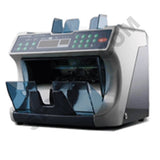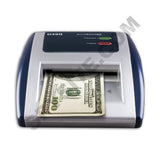The newer bills look dramatically different than their predecessors. The featured presidents are larger in size. Patriotic icons, like the bald eagle, have been added. The bill denominations are more pronounced. Each denomination number is a different color.
Other security measures have been taken. Newer bills are printed with magnetic ink. Watermarks have been added. The treasury also started using a micro-printing process that is more difficult for counterfeiters to reproduce. Security threads, which were added to larger bills in the 1980s, are still used today.
Types of Counterfeit Detectors
New security measures make counterfeiting more difficult. They also make spotting counterfeits a long and tedious process, especially if your business accepts a large amount of cash each day. That's why many businesses rely on counterfeit detectors. These detectors are reasonably priced and provide a great deal of protection to those accepting cash.Counterfeit Banknote Detection Pens
The most widely used counterfeit detector is the banknote detector pen. Real money is printed on paper that contains cotton fibers. A large number of counterfeiters use standard photocopier paper to print counterfeit currency. The banknote detection pen uses iodine as ink. When iodine is applied to standard photocopier paper, it turns a bright color. When iodine is used on real money, there is no significant change in color.
Electronic Counterfeit Detectors with Ultraviolet Light

Electronic Counterfeit Detectors with Fluorescent Light
Watermarks are fairly easy to see, unless your business operates in low-light conditions. Electronic counterfeit detection systems that use fluorescent light focus on detecting these watermarks. Some detectors give the user a green light when the watermark is detected. Some models are not automated and only provide adequate lighting for the user to find the watermark themselves.
Electronic Counterfeit Detectors with Low-Field Magnetic Testing
Many decades ago, small magnets were placed inside of banknotes. If a bill was accidentally torn and worn out, the magnet could slip out. Because the magnets were easy to see, some people intentionally removed them. Newer bills are printed with ink that includes traces of magnetic material. Low-field magnetic testing can verify the presence of magnetic ink, which is otherwise visibly impossible to

Electronic Counterfeit Detectors with Micro-print Technology
These detection systems are probably the most advanced. Detecting and replicating micro-print technology is a difficult process. Micro-printing uses a variety of colors and unique patterns. It also embosses small areas of the bill. The treasury even used micro-printing to add hidden words to banknotes. Machines that detect micro-print know where to look and what to look for when checking each bill.
What Type of Machine Do You Need?
Let's return to the efficiency of the bank note detection pen, which is widely used by businesses. While this pen does offer some protection, it is the least effective product you can buy for detecting counterfeit currency. Some counterfeiters are now using starch-free paper, which does not react with iodine the way traditional photocopier paper reacts. These pens also cannot detect bleached money. To bleach money, a counterfeiter removes ink from a small bill, such as a $1 or $5 bill. The counterfeiter then prints new numbers on the bill, turning small bills into large bills. For these reasons, it is obvious that any business looking for protection should invest in an electronic detector.
Testing bills for any one security feature offers only limited protection. Many counterfeiters have access to technology that can produce remarkable replicas. It is rare, however, that they can fake every security feature. For instance, watermarks can be printed using some printers. There are inks available to the general public with magnetic properties. Micro-print is a little more advanced than the other security features found on paper currency, but it doesn't stop counterfeiters from trying. Fortunately, basic machines that can detect all four security measures are available for around $100.
The U.S. Treasury plans to redesign bills every 7-10 years in order to stay ahead of counterfeiters. It's safe to assume additional security features will be added to paper currency in the future. In the meantime, protect yourself by investing in a counterfeit detector.



